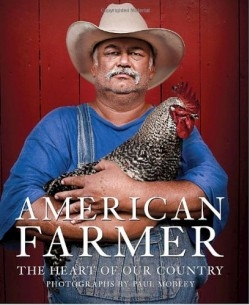American Farmer
The Heart of Our Country
“Cultivators of the earth are the most valuable citizens. They are the most vigorous, the most independent, the most virtuous,” Thomas Jefferson said. It is this vigor, virtue, pride, and diligence that Paul Mobley sets out to capture through his collection of photographs in American Farmer. The collection creates a quilted pattern of American life on the modern farm. From Arizona to Alaska, Mobley’s lens does more than simply produce still life images of these farmers and their families—his pictures tell a rich story of the land and those who are married to it.
The vivid photographs frequently focus on the bright greens of John Deere, and the emerald landscapes that serve as backdrops for many of the individuals featured; these greens are startlingly contrasted by the brick red of International tractors or the blue of many farmers’ denim. The effect of such richly colored portraits is dazzling, especially when such color is featured next to intimate black-and-white close-ups of weathered farm faces. Such contrasts are most artistically moving when Mobley situates color and black-and-white on the same page, sometimes forcing the reader to see greater parallels between generations.
An example of this striking parallelism is a young boy, Trey Lacina, who is featured on the left in full color with green grass and brown cows in the background. On the right-hand side of the same page, Lacina’s grandfather, Keith Nelson, is pictured in black-and-white, hands shoved in his pockets in the same stance and with the same expression as his grandson. The contrast between young and old, color and black-and-white, reinforces a key theme in the book: despite change and modernization, there is the permanence of the land, and the occupation itself. Thus, many pictures feature farmers not as individuals, but as families and as generations, like the book’s last picture of the Bell family.
The Bells are organic dairy farmers in Maine, and the photograph features the entire family perched atop rough looking rocks with Maine’s crisp blue sky in the background. All together, there are seventeen Bells present in the picture and each one of them is focused on the camera with the same dedicated look in his or her eye. In the image, they are not separated from the hard stones they sit atop; instead, they are a fixture of the landscape. Again and again, the farmer’s personal tales, edited by Katrina Fried, express farming’s longevity and the importance of heritage. Farms and ranches are passed from generation to generation, and through both the pictures and the stories, readers can see that this is a connection that’s not learned; it’s inherited. “I’m living in the same house I was born in ninety-one years ago,” says Ernie Righetti, an avocado grower in California. “My grandfather bought the ranch in 1890.”
The book’s text, composed of the farmers’ personal tales, is a clear reflection of the people telling the stories and the portraits that Mobley creates. The language and the sentences are straightforward, direct, and to the point. While the stories are distinctly different from one another, there are shared themes: permanence is certainly one of them, but another common theme is their motivation—“We’re not doing it to become rich,” says Andrea Dockery, a Wyoming rancher, “we’re doing it because we love it. We love the land and the way of life.” It’s a startling sentiment when one considers that these are modern farmers, living in modern America. These people—farmers and ranchers—still embody an original sense of the American spirit, and it’s not an ideal that’s based on monetary success; in some ways, this business is not even work for them. It’s a way of life. “Farming isn’t work,” LaDene Rutt of Nebraska comments. “It’s what I do.”
The passion and devotion of these people are the true essence of what Mobley’s pictures express, and what the personal stories, edited by Fried, reinforce. The combination is breathtaking. American Farmer is a richly layered mosaic of brilliant visuals and honest text that honors farmers and ranchers across America. Mobley’s keen vision of the American farmer, and his ability to capture the spirit which each farmer embodies, will impress readers.
Disclosure: This article is not an endorsement, but a review. The publisher of this book provided free copies of the book to have their book reviewed by a professional reviewer. No fee was paid by the publisher for this review. Foreword Reviews only recommends books that we love. Foreword Magazine, Inc. is disclosing this in accordance with the Federal Trade Commission’s 16 CFR, Part 255.

